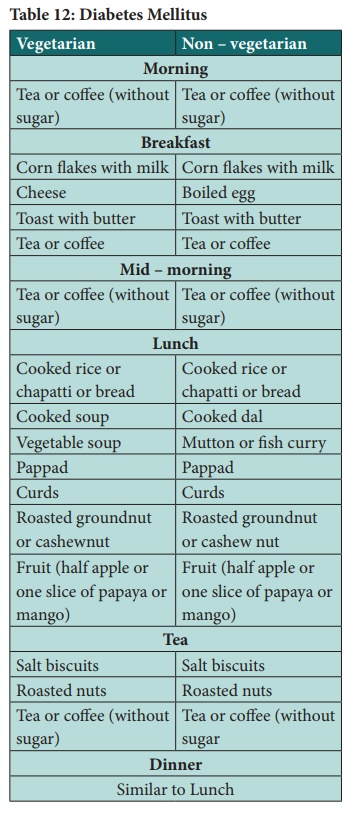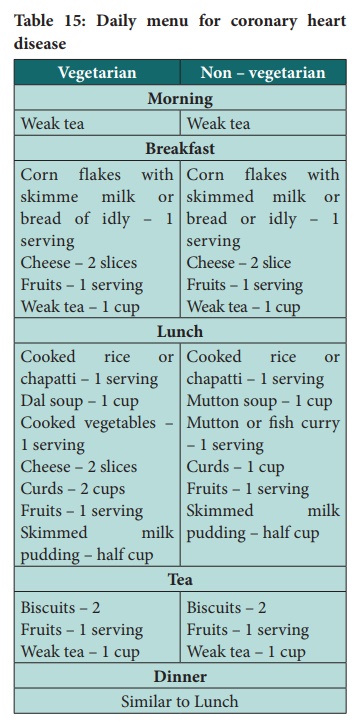Principle - Therapeutic Diets | 12th Nursing : Chapter 5 : Applied Nutrition
Chapter: 12th Nursing : Chapter 5 : Applied Nutrition
Therapeutic Diets
Therapeutic Diets
Modification of nutrients in therapeutic Diets
The general principles of nutrition related to health apply also
to the treatment of patients suffering from various diseases. Diet in disease
must be planned as part of the complete care of the patient many modifications
may have to be made according to the disease and the condition of the patient,
but there are certain general principles which may be used for guidance.
Principle of Therapeutic Diets
·
Carbohydrates are
usually well – tolerated and are necessary to maintain the stores of liver
glycogen.
·
The tolerance of fats
varies in different individuals and this nutrient should not be forced if there
is nausea and vomiting.
· In illness, there is usually an increased demand
for proteins, due to wasting and this should be given in easily digestible
forms such as milk, egg, chicken and fish.
·
The requirements of
calcium and iron must be maintained during illness and it is necessary to
check.
·
Fat – soluble vitamins
often need to be added as concentrates if a patient has to be on a fat –
restricted diet for a long time. The demand for Vitamin C is greatly increased
in fevers, and it is especially necessary for the healing of wound after
surgery.
·
Roughage: Excessive bulk
hinders the penetration of the digestive juice, but it may be necessary to
include foods with a moderately high residue content to produce daily bowel
action.
·
Fluids are very
important to prevent dehydration which is common in conditions of fevers,
diarrhea and vomiting. In such condition 2,500 –3,000 ml must be given in 24
hours with as much variety as possible, both in appearance and in taste.
1. Diabetes Mellitus
Diabetes mellitus is a condition in which the secretion of insulin
by the islets of Langerhans in the pancreas is deficient or absent. It is
characterized by hyperglycemia,
Table 12: Diabetes Mellitus

Table 13: Daily menu for high blood pressure

2. Hypertension
Hypertension develops due to some reason, there is increased
resistance to the normal circulation of blood. This may be temporary, as the
result of exercise, pregnancy, or menopause; it may be permanent, associated
with atherosclerosis, cardiac failure or chronic kidney disease.
Notes
1. Salt should not be added in cooking
2. One multivitamin tablet providing the daily requirements of all
essential vitamins should be included along with the diet
3. Strong coffee is not permitted.
Table 14: Daily menu for Hypertension

3. Coronary Heart Diseases
A majority of coronary heart diseases are due to coronary
antheroma (A fatty deposit in the inner lining of an artery) and
atherosclerosis, are used to denote conditions in which lipid is deposited in
the intima of the blood vessels.
Calories – 1800 – 2000 Kcal; Fat (rich in essential fatty acids) –
60 gm; Proteins – 50 – 60 gm
Note: one multivitamin tablet providing the daily requirements of
all essential vitamins should be given daily.
Table 15: Daily menu for coronary heart disease

4. Chronic Renal Failure
Chronic Renal Failure occurs in glomerulone phritis,and chronic
pyelonephritis. In this condition,the glomeruli and tubules are heavily
damaged.
Diet
The diet in chronic uratemia (presence of abnormal of uric acid
salts in the blood) should be below in protein depending on the urea content of
blood. The pattern of diet and the daily menu for an adult suffering from
chronic renal failure are given in Tables 16 and 17.
Table: 16 Diet for an adult suffering from chronic renal failure
(Calories 1500 – 2000 Kcal; Proteins 15 – 20 gm; Fat 40 – 50 gm,
Carbohydrates 300 – 40 gm; Salt free)

Table 17: Daily menu for chronic renal failure

Note: Common salt should not be added during or after cooking.
One multivitamin tablet providing the daily requirements should be taken
5. Peptic Ulcer
Chronic ulcer formed in the region of the gastrointestinal tract
where the gastric juice comes in direct contact with the mucous membrane is
known as peptic ulcer. Such ulcers usually occur in the duodenum (duodenal
ulcer) and in the stomach (gastric ulcer). Duodenal ulcer is associated with
hyperacidity while gastric ulcer is not.
Diet in Peptic Ulcer
The diet is the most important factor in the treatment of peptic
ulcer. Three main types of diets have been used in the treatment of peptic
ulcer.
Table 18: Types of therapeutic diet for peptic ulcer

Sippy’s diet consisting of milk and olive oil was used widely.
Since it is monotonous and not adequate to meet the calorie needs, it has been
replaced by a bland diet containing large quantities of milk.
Table 19: Diet for adult suffering from peptic ulcer
(gm/caput/day)

Note: One vitamin C tablet (100mg) may be taken once daily.
Table 20

Table 21: Foods permitted and not permitted in peptic ulcer

Related Topics